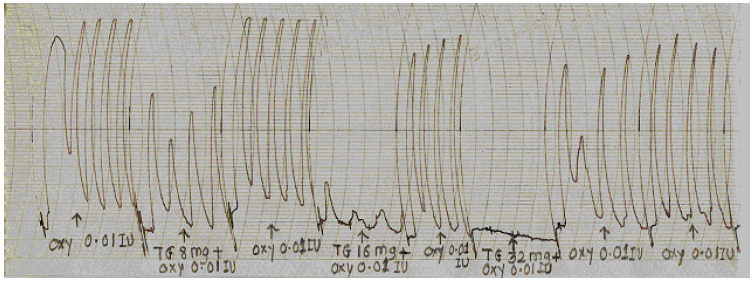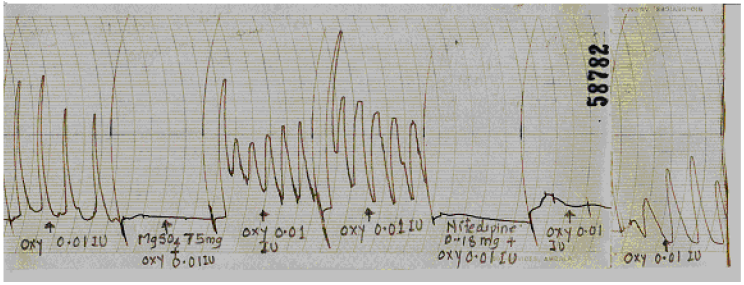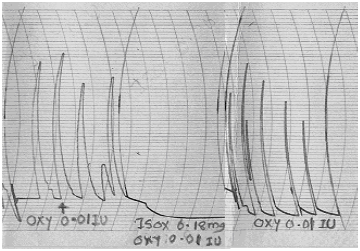About Author: Deepali Jaybhaye, Sushilkumar Varma, Amol Gite
Department of Pharmacology, Mahatma Gandhi Mission Hospital,
Aurangabad, Maharashtra – 431001, India.
Vijay Bonde
Department of Pharmacology, Mahatma Gandhi Institute of Medical Sciences,
Sewagram, Wardha, Maharashtra – 402102, India.
Reference ID: PHARMATUTOR-ART-1052
Abstract
Tectona Grandis linn. is one of the well known Indian herbs. In Ayurveda Tectona grandis stem extract has tocolytic effect. The main syndrome of preterm birth is caused by uterus contractions from excitatory factors. Administration of tocolytic agents is a strategy to prevent the occurrence of preterm births. The aim of this study was to investigate the effects of Tectona grandis stem extract on the contractions of uterine strips isolated from non?pregnant female Wistar rats (250~350 g) prior injected (Before 24 Hrs) Estradiol benzoate. Contractions of the uterus were induced with Oxytocin 0.01 IU. The results compared with stander drugs like Magnesium Sulfate (75 mg), Nifedipine (0.18 mg), and Isoxsuprine (0.18 mg) along with their effect on frog blood vessels, rat and frog heart, skeletal muscle. After seeing these effects we conclude that Tectona grandis stem extract possess the same tocolytic effect as that of standard drugs.
Introduction
After pregnancy, the endocrinology of the body of pregnant women obviously changes, including uterine contraction agonist receptors (such as oxytocin receptor, prostaglandin receptor, β?adrenergic receptor, and corticotrophin releasing hormone receptor), and ion channel proteins which determine the resting membrane potential and excitability of myocytes. [1, 2] Dysfunctional uterine contractions can lead to premature delivery. Spontaneous preterm labour and delivery accounts for approximately one?third of preterm births, which is the predominant cause of prenatal mortality and morbidity. The wide range of tocolytic agents in use is testament to the fact that we still do not have an ideal drug available. [3] Therefore, development of new safe and effective tocolytic agents is an
important research topic.
Many unknown and lesser known plants are used in folk and tribal medicinal practices in India. The medicinal values of these plants are not much known to the scientific world. Tectona grandis (family ? Verbenaceae) is one such medicinal plant.
According to Ayurveda, Tectona grandis wood is acrid, cooling, laxative, sedative to gravid uterus and useful in treatment of piles, leucoderma and dysentery. Roots are useful in anuria and retention of urine. [4, 5] The flowers are acrid, bitter dry and cures bronchitis, biliousness, urinary discharges etc. [4] According to Unani system of medicine, oil is useful in scabies whereas wood is best for headache, biliousness, burning pains particularly over the region of liver. It allays thirst, and act as anthelmintic, expectorant and antiinflammatory. [4, 5] The bark is astringent, acrid, cooling, constipathing, anthelmintic and depurative. It is useful in bronchitis,
hyperacidity, vitiated conditions of pitta; dysentery, verminosis, burning sensation, diabetes, leprosy and skin diseases. [6]
Tectona grandis is also known as saka in Sanskrit, sagun in Hindi, sagwan in Marathi and Teak tree in English. [5] Lapachol, a naphthaquinone isolated from the roots of Tectona grandis have an anti ?ulcerogenic effect, on subsequently induced experimental gastric and duodenal ulcers in rats and guinea?pigs. [7] Tectona grandis sawdust extract inhibited the growth of Aspergillus Niger the active compound was identified as deoxylapachol and
tectoquinnone. [8] Tectona grandis has been investigated for nitric oxide scavenging activity. [9] Wound healing activity in rat. [10] Tectona grandis contains tannin, which are used as antiinflammatory agents and also used topically for treatment of burns. [11, 12] The effect of Tectona grandis stem extract on the uterus is still unknown. The tocolytic effect of Tectona grandis is demonstrated in the present study.
MATERIALS AND METHODS
Materials
The fresh stems of an herbal plant Tectona grandis Linn. were collected from Mahatma Gandhi Institute of Medical Sciences College Campus area and authenticated by local Botanist. The stems were shade dried and powdered. The powder was macerated for 24 hours in 70 % v/v ethanol. Then they were subjected to percolation by using 70 % v/v ethanol as a solvent. Percolated solution was again shade dried and the extract was used to prepare an aqueous solution in desired concentration just before use every time. Oxytocin, Nifedipine, Magnesium sulfate, Isoxsuprine drugs
solution was prepared in desired concentration in distilled water just before use. Estradiol benzoate 100 μg/ kg subcutaneously 24 hours before experiment used to get rat uterus in estrus phase. De Jalon’s Physiological salt solution for rat uterus: NaCl ? 9 gm /L, KCL ? 0.42 gm /L, CaCl2 – 0.06 gm /L, NaHCo3 – 0.5 gm / L, Glucose – 0.5 gm / L added to 1 liter of distilled water.
Animals
From Pharmacy College of Borgaon (Meghe), National Centre For laboratory Animal Sciences (N.I.N Hyderabad) after taking permission from local ethical committee. They were caged in wire mesh cages in the animal room of Department of Pharmacology under standard condition of environment, temperature, food and water. The animals were allowed to take rest for a period of one week, so that they are adapted to the new surrounding before subjecting them to experimentation.
Wistar rats: Healthy non pregnant female adult wistar rats weighing (250~350 g) were used to evaluate the effect of test on oxytocin induced uterine contractions.
Methods
Effect of Tectona grandis stem extract on oxytocin induced rat uterus contractions
The rat uterus preparation was done according to Vogel HG method. [13] This experiment was done to study the effect of hydroalcoholic stem extract of Tectona grandis Linn preincubated on oxytocin induced contraction in rat uterus and evaluating the effect on the basis of prostaglandin biosynthesis described by Vane and Williams in 1973.
Adult female rats were primed with single dose of estradiol benzoate (100 μg/ kg, subcutaneously) 24 hours before experiment. The rat was anesthetized by ether and abdomen opened. Two horns of uterus were identified, dissected out and transferred to a dish containing De Jalon’s solution. The two horns were separated and free from fat and each was cut opened longitudinally so that the preparation was a sheet of muscle
instead of narrow tube.
A thread was attached to each end of piece and preparation was mounted in 20 ml organ bath perfuse with De Jalon’s solution which was aerated with oxygen (95%) and carbon dioxide (5%).\ The tissue was equilibrated till spontaneous contractions were abolished during which the physiological saline solution was replaced every 10 minutes and temperature of (30?32 °c) was maintained.
Table 1. Effect of Tectona grandis extract on oxytocin induced contraction in rat uterus
| Group | Drug | Concentration |
Height of Contraction (cm) (mean ± SD) |
% Inhibition |
| I | Oxytocin | 0.01 IU/ ml | 5.1 ± 0.5 | - |
| II | T.G extract + Oxytocin | 8 mg/ml + 0.01 IU/ml | 1.7 ± 2.1 | 66.6 % |
| III | T.G extract + Oxytocin | 16 mg/ml + 0.01 IU/ml | 0.4 ± 0.3 | 92 %*** |
| IV | T.G extract + Oxytocin | 32 mg/ml + 0.01 IU/ml | 0 | 100 %*** |
| V | Mag.Sulfate + Oxytocin | 75 mg + 0.01 IU | 0 | 100 %*** |
| VI | Nifedipine + Oxytocin | 0.18 mg /ml + 0.01 IU/ ml | 0 | 100 %*** |
| VII | Isoxsuprine +Oxytocin | 0.18 mg/ml + 0.01 IU/ ML | 0 | 100 %*** |
n = 6; SD = Standard deviation; IU=International units; TG = Tectona grandis Linn stem extract. *** p value < 0.001
 Figure 1. Effect of Tectona grandis stem extract (in graded doses 8, 16, 32 mg) on oxytocin induced contractions in rat uterus
Figure 1. Effect of Tectona grandis stem extract (in graded doses 8, 16, 32 mg) on oxytocin induced contractions in rat uterus

Figure 2. Effect of magnesium sulfate (MgSO4 ? 75 mg) and nifedipine (0.18 mg) on oxytocin induced contractions in rat uterus

Figure 3. Effect of isoxsuprine (Isox? 0.18 mg) on oxytocin induced contractions in rat uterus
The response of uterine tissue to oxytocin (0.01 IU/ml or 0.02 μg/ml) before and after incubation of tissue with stem extract of Tectona grandis Linn. (8? 32 mg) for three minutes were recorded on a physiograph along with other drugs like magnesium sulfate (75mg), Nifedipine (0.18 mg) and Isoxsuprine (0.18mg). The percentage inhibition of original response was calculated indicating inhibitory action on the basis of prostaglandin biosynthesis.
Statistical Analysis
The results are expressed as the mean ± SD of several preparations (n) from different animals. Agonists were added until the steady, largest amplitudes were defined as the maximal contractions Relaxation was expressed as a percentage of inhibition of the maximal contraction obtained by adding the drug. Statistical significance of differences between groups was assessed using Student's t?test. P values of < 0.05 were considered significant.
RESULTS
Effect of Tectona grandis extract on oxytocin induced contractions in rat uterus
The Tectona grandis extract in different doses (8, 16, 32 mg) showed significant (p < 0.001) inhibition of height of contraction induced by oxytocin (0.01 IU/ml) in a dose dependent manner. The maximum inhibition of height of contraction by Tectona grandis was observed in 32 mg/ml dose. While standard drug like magnesium sulfate, nifedipine and isoxsuprine shows the inhibition of uterine contraction on their therapeutic doses in rat i.e. 75 mg, 0.18 mg and 0.18 mg in 250?350 gm rat (Table 1, Figure 1, 2, 3).
DISCUSSION
Activity of stem extract of Tectona grandis on rat uterine contraction induced by oxytocin studied by the method described by H. Gerhard Vogel march 2002 [13] on the basis of prostaglandin biosynthesis as per Vane and Williams 1973.
Tectona grandis stem extract has shown uterine relaxant activity in dose dependent manner (Table 1, Figure 1, 2, 3) complete inhibition of contraction (100%) was noted in 32 mg dose of Tectona grandis stem extract same as that produced by standard uterine relaxants i.e. injection Magnesium sulfate (75 mg), Cap. Nifedipine (0.18 mg), injection Isoxsuprine (0.18 mg) (FIG.1B,C) where p value was highly significant (p<0.001).This activity because of inhibition of prostaglandin biosynthesis.[13] This shows that Tectona grandis stem extract have similar activity as magnesium sulfate, nifedipine, isoxsuprine but differ in the dose.The uterine relaxant effect of Tectona grandis stem extract supported
documentation of relaxant effect in Ayurveda. [5, 14] This is also confirmed
in our study.
We also tried this experiment on normal i.e. without the prior injection of
oestradiol uterus of rat but there is no contraction after giving oxytocin
may be due to non induction of oxytocin receptors. [13]
CONCLUSION
Tectona grandis stem extract was equally effective in suppuration of uterine contraction as that of magnesium sulfate, nifedipine, Isoxsuprine. From these findings we can conclude that the Tectona grandis is a better choice among all the available drugs because it produces the same type of relaxant effect like magnesium sulfate, nifedipine, isoxsuprine and it is
also available locally so it is economical than other drugs. Preliminary study has shown that the efficacy of this medicinally important plant Tectona grandis as tocolytic agent. Further, active research is underway in our laboratory to elucidate the other pharmacological actions on different organs of body.
References:
1. Sam MM. Progesterone responsiveness and the control of human parturition. Reprod Sci 2004; 11(4):193 ?202.
2. Shih HC, Hsu CS, Yang LL. In vitro study of the tocolytic effect of oroxylin A from Scutellaria baicalensis root. Journal of Biomedical Science 2009; 16 ? 27.
3. Tan TC, Devendra K, Tan LK, Tan HK. Tocolytic treatment for the management of preterm labour: a systematic review. Singapore Med J 2006; 47(5):361 ?366.
4. Oudhia P. Medicinal herbs of Chhattisgarh, India, having less known traditional uses. I. Sagon Tectona grandis, family Verbanaceae. Botanical.com © 2001, 2002, 2003.
5. Sharma PV, Shaka Riktniryas. Text book of Dravya. Guna: Chaukhambha Bharti Academy;1986, 791 ?793.
6. Ghaisas M, Navghare V, Takawale A, Zope V, Tanwar M, Deshpande A. Effect of Tectona grandis Linn. on dexamethasone?induced insulin resistance in mice. J Ethnopharmacol. 2009; 122 (2):304 ?7.
7. Goel RK, Pathak NK, Biswas M, Pandey VB, Sanyal AK. Effect of lapachol, a naphthaquinone isolated from Tectona grandis, on experimental peptic ulcer and gastric secretion. J Pharm Pharmacol 1987; 39(2): 138 ?140.
8. Sumthong P, Damveld RA, Choi YH, Arentshorst M, Ram AF, Van den Hondel CA, Verpoorte R. Activity of quinines from teak (Tectona grandis) on fungal cell wall stress. Planta Med 2006; 72(10):943 ?944.
9. Jagetia GC, Baliga MS. The evaluation of nitric oxide scavenging activity of certain Indian medicinal plants in vitro: a preliminary study. J Med.Food 2004; 7(3): 343 ?348.
10. Majumdar M, Nayeem N, Kamath JV, Asad M. Evaluation of Tectona Grandis leaves for wound healing activity. Pak J Pharm Sci 2007;20(2):120 ?124.
11. Evans WC. Trease and Evans’ Pharmacognosy. 14th ed. New Delhi: Harcourt Brace and company; 1998, 227.
12. Shah CS, Qadry JS. A text book of Pharmacognosy. 11th ed. New Delhi: B S Shah Prakashan; 1995, 155.
13. Vogel HG, Drug discovery and evaluation pharmacological assays, Oxytocin, Walfgang H. Vogel, 2nd edition, March 2002, 1237 ?1238.
14. Neamatallah A, Yan L, Dewar SJ, Austin B. An extract from teak (Tectona grandis) bark inhibited Listeria monocytogenes and methicillin resistant Staphylococcus aureus. Lett Appl Microbiol 2005; 41(1):94 ?6.











.png)


